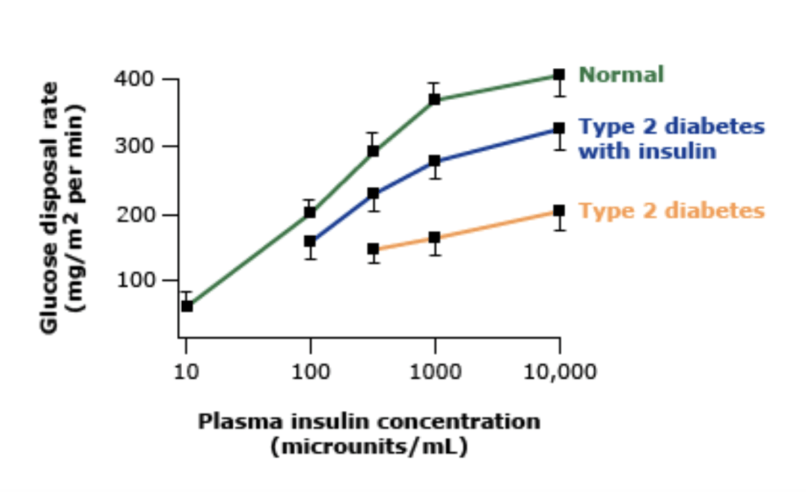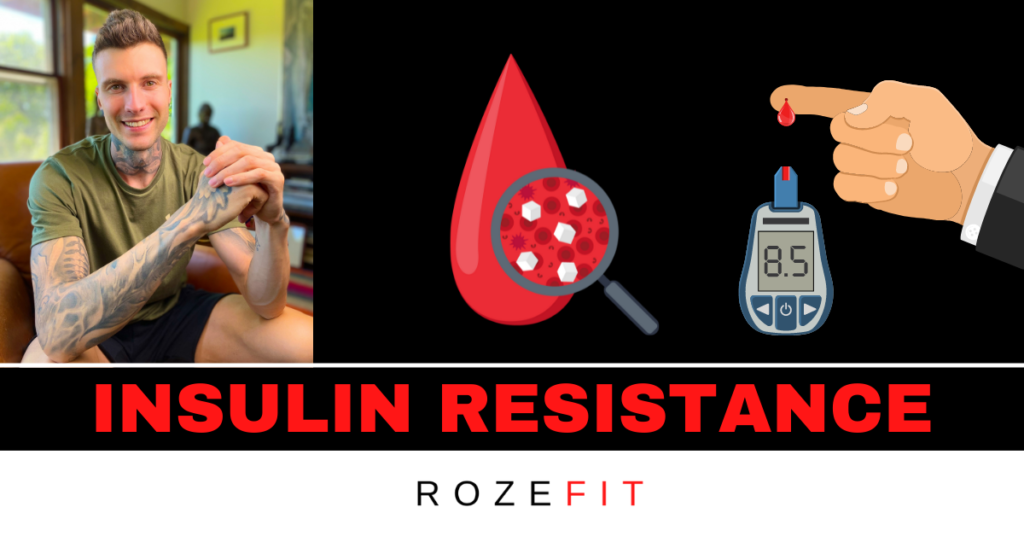As a personal trainer that specializes in metabolic health, one of the most important topics that I discuss with my clients is insulin resistance.
If your doctor recently told you that you have high blood sugar or borderline high blood sugar, it is important that you understand how it relates to insulin.
Because insulin resistance is ultimately the cause of high blood sugar.
What is Insulin Resistance?

Simply put, insulin resistance is an impairment of the hormone insulin to transport glucose into the muscle and liver.
Every time that you eat something with glucose, your pancreas releases insulin which binds to the insulin receptors on the surface of your muscle cells.
When insulin binds to the insulin receptor, it sends the glut 4 transporter to the surface of the cell and glucose is allowed to pass into the cell.
This process is demonstrated in the picture above.
When someone is insulin resistant, glucose uptake by the muscle is impaired and is unable to be stored as glycogen.
The result is high blood sugar levels.
The Effects of Insulin Resistance

The less sensitive your cells are to the signal of insulin, the more of it is required to get glucose into the cell.
You can see in the graph above that the severely insulin resistant individual – aka the type 2 diabetic – is unable to dispose of glucose properly.
They require a lot of insulin for just a little bit of glucose to be cleared.
Eventually your cells require so much insulin to get glucose into the cells that your cells no longer recognize the signal of insulin.
Then you are by definition insulin resistant.
When Does Insulin Resistance Start?
The first time most people realize they are insulin resistant is when their doctor tells them that their blood sugar is high.
But the reality is, insulin resistance starts well before the presentation of high blood sugar.
Because ultimately you cannot have chronically high blood sugar without having an impairment in the function of insulin first.
Before someone presents with high blood sugar, they have been building a resistance to insulin.
Think about it – if insulin was doing its job, then their blood sugar would not be elevated in the first place.
Unfortunately, insulin response is rarely tested to screen for the early stages of insulin resistance and it is only until your fasting blood sugar is high that you are diagnosed with pre type 2 diabetes or type 2 diabetes.
Insulin Resistance Progression

Interestingly, there is a typical progression from normal to severely insulin resistant.
1.) In a normal individual, glucose stays relatively low after ingestion and so does insulin.
2.) Then, in the beginning stages of insulin resistance you see an elevation in insulin but not glucose.
3.) Then, once the individual becomes insulin resistant you see an elevation of both glucose and insulin.
4.) Then once they become severely insulin resistant you see an elevation of both fasting glucose and fasting insulin.
At this point, the individual presents with high fasting glucose and they are diagnosed with pre type 2 diabetes or type 2 diabetes.
How to Reverse Insulin Resistance

So if you want to improve your metabolic health, become insulin sensitive again, and lower your blood sugar levels – you have to implement an exercise and diet strategy.
Exercise is the most powerful lifestyle drug we have to combat insulin resistance.
Check out this study from the New England Journal of Medicine.
They found that a single bout of aerobic exercise was able to boost insulin sensitivity and glucose disposal!
That’s how powerful exercise is when it comes to improving your metabolic health.
I prescribe all of my clients with high blood sugar and insulin resistance aerobic exercise several times a week.
Specifically, there is a special type of cardio called Zone 2 training that improves insulin sensitivity and lowers blood sugar levels.
I have written several articles about this type of cardio which you can find here.
You can also find out more about my remote coaching services here if you need help improving your metabolic health.
I look forward to hearing from you!

